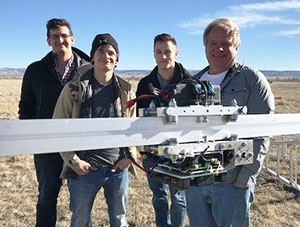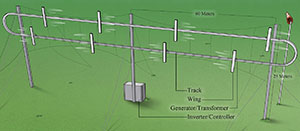
Contact Us
Institutional Communications
Bureau of Mines Building, Room 137
Laramie, WY 82071
Phone: (307) 766-2929
Email: cbaldwin@uwyo.edu
AirLoom Energy Graduates from WTBC, Moves to West Laramie
Published February 01, 2019

Justus Kornkven, from left, a 2017 UW graduate in physics from Casper; Alex Skorcz,
a UW student from Rock Springs majoring in mechanical engineering; Zach Tovar, a UW
student from Longmont, Colo., majoring in electrical engineering; and Robert Lumley,
founder of AirLoom Energy, pose next to a portion of Lumley’s AirLoom system, set
up near the UW Cliff and Martha Hansen Livestock Teaching Arena. (Mookwon Seo Photo)
Robert Lumley can still remember the moment he and his wife pored over a United States map, looking for the windiest place in the nation. They found it: a spot located between Cheyenne, Laramie and Wheatland.
A few months later, Lumley flew to Laramie, where he met with Jonathan Naughton, a University of Wyoming professor of mechanical and energy systems engineering and director of UW’s Wind Energy Research Center. Lumley wanted to discuss his idea of creating a less-expensive wind turbine system that operated on a system of established technology derived from horizontal-axis wind turbines (HAWTs) with kite concepts.
Fast forward three years, and this month marks a big step for Lumley and his company, AirLoom Energy. The business, which got off the ground in July 2016 with a Small Business Innovation Research (SBIR) grant from the National Science Foundation (NSF), has spent nearly the past three years using incubator space in the Wyoming Technology Business Center (WTBC).
The business graduated from the WTBC in January and has moved its operations to roughly 20,000 square feet of warehouse space in west Laramie.
“It’s a very unique wind turbine,” says Lumley, who moved to Laramie from Santa Barbara, Calif., in 2015. “We are moving to warehouse space because we are ready to do our Beta version of this.”
While time spent at the WTBC involved working with computer models, the warehouse will provide the space necessary to install a large track to validate the computer models and data control systems, Lumley says.
Lumley’s vision for a smaller, more efficient wind turbine system began in 2009 while he was riding a kiteboard in Kauai. The wind came up and filled the sail, and the sudden power had him gliding efficiently along the surface of the water. The experience got Lumley thinking of a system of kites could be used to generate wind energy.
The AirLoom system is 23 times lighter and 15 times cheaper than today’s wind turbine technology, he says. In his technology, Lumley’s system uses small gliders that act as hybrids of kites and HAWTs that travel along an oval track, where they continuously capture energy from wind. Magnets are mounted on each moving glider. The magnets create an electric current in the winding, located next to the rail.
Lumley says his system sits much lower to the ground than the giant turbines that can be seen from Interstate 80 or Happy Jack Road near Cheyenne.
“Either it changes the world, or I’ve wasted a lot of time,” he says, with a laugh.

This rendering shows Robert Lumley’s AirLoom system, which uses small gliders that
act as hybrids of kites and horizontal-axis wind turbines that travel along an oval
track, where they continuously capture energy from wind. Magnets are mounted on each
moving glider. The magnets create an electric current in the winding, located next
to the rail. (Leanne Kroll Illustration)
In July 2016, Lumley received a $250,000 SBIR grant from NSF that allowed him to build a working prototype of his parented system. In 2017, the NSF provided $750,000 in continued funding for the project.
“Everybody wants cheaper electricity and cheaper wind power,” Lumley says. “The biggest cost is the capital cost of the equipment. I think once the technology is proven, it should take off quickly. We have five companies that want to purchase this system. We just want to make it work.”
He credits the WTBC, the Wyoming Small Business Development Center and the state of Wyoming with being very supportive of his venture through the grant application process. Additionally, the WTBC provided Lumley incubator space and access to UW faculty members, including Myron Allen and Craig Douglas, both in the UW Department of Mathematics. Lumley also was asked to give a speech at U.S. Sen. Mike Enzi’s Inventors Conference in Cheyenne in 2016.
“I’m just a guy with an idea who gets to spend a day with a U.S. senator,” Lumley says, with a slight shrug. “Maybe that’s normal in Wyoming, but it’s not in California.”
During his time at the WTBC, Lumley also built a staff of four full-time and two part-time employees. Of the full-time employees, Justus Kornkven, of Casper, and Mookwon Seo, of Korea, are both UW graduates. Current UW students Alex Skorcz, of Rock Springs, and Garrick Tolman, of Otto, are serving as interns at AirLoom Energy. All will continue at the west Laramie site.
“If I am giving a speech in 10 years and giving a TED (Technology, Entertainment, Design) Talk, I would tell any entrepreneur to move to Laramie. I-80 is right there. Denver International Airport is two hours away,” Lumley says. “Some people don’t like the windy days. I know the trucks on I-80 don’t. But, I do.”
For more information about AirLoom Energy, visit www.airloomenergy.com/.
Contact Us
Institutional Communications
Bureau of Mines Building, Room 137
Laramie, WY 82071
Phone: (307) 766-2929
Email: cbaldwin@uwyo.edu
